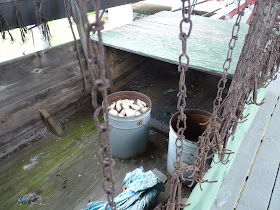I wondered about this boat.
What was it? Why so many hooks? I've seen this boat every time I've visited or performed at the museum but never paused long enough to really look at it or read the information panels.
Mussels? Buttons? Really?
Really.
In the early part of the 1900's fishing for mussels became a popular activity along the Ohio River. At first the mussels were a novelty and people looked for them to get the freshwater pearls hidden inside. The mussels were cooked in large bonfires and the cooked meat inside discarded or fed to the dogs--people rarely if ever eate them. What a wastes.
But an industry soon developed that focused not on pearls but on a different use: button-making.
A factory to manufacture shell buttons was built in St. Marys, WV in 1910 and remained in operation until 1928. Another factory was located at Newport, Ohio and there were others further downstream.
| from WVGenWeb |
| mussel fisherman, from the Smithsonian's National Museum of American History collection |
Poaching and over-fishing the mussels led to a sharp decline in their numbers, and mussel-fishing was eventually outlawed. It is making a slow, controlled comeback today, under strict regulations. They are no longer harvested for buttons however; that industry died out with the coming of plastic buttons.Before the decline of mussels it was discovered that the shells could be ground into little pellets, which were then shipped overseas to be implanted in oysters--the pellets developed into what are called cultured pearls. This is still the current use for mussel shells.
The zebra mussel, an invasive, non-native species, is now threatening the native mussel population and is a cause of great concern.
But about those boats:
The mussel boats were flat-bottomed jon boats, fitted with a rack on which long poles holding a multitude of strong lines with four-pronged hooks at the end, called brails.
 |
| At the Ohio River Museum, Marietta |
When brailing, the poles would be lowered and the brails dragged through the water. Each hook had a small ball on the end that the mussels would grab hold of. Musselers could tell by the weight on the pole when it was time to pull the brail in.
Nathan Lynn, who provided music and river history during the Inland Waterways Festival last weekend, used to go musseling with his father, who did this for a living at the time. His description of the process, and the song he wrote about it, made me wish I'd been a river rat when I was young too.
Each pole had 30 or 40 heavy lines going down from it, and at the bottom of each line were study [this is the word used—seems it would have been sturdy mm] hooks, each with four barbs. The poles were lowered into the water and towed along, lines and hooks dragging the bottom. As a hook slid into an open mussel shell, the shell closed over it. At intervals, the workers raised up the poles and the mussels were pried off and tossed into the bottom of the boat."
I had to go looking in my button jar for shell buttons. I found that I did have a few:
Then I looked on ebay and found this mussel hook, a cut shell and blank buttons. These are now on their way to me! Because, you know, I just might be developing a new story about musseling and buttons.




You could write a grave or history book about West Virginia
ReplyDeleteAmazing what you discover !!!
You have found so many famous places
ReplyDeleteAmazing
Very interesting! I have never visited the museum but now have it on my list of places to go. I love your collection of mussel shell buttons. They are each so unique in their appearance. I didn't realize that the mussels were not eaten. Seems such a waste. I really enjoy your posts!
ReplyDelete